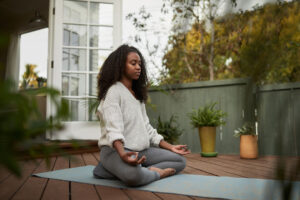Breathing and oxygenation are critical to avoiding stress primarily because they keep acidosis away.
Blood tends to be alkaline because the vital combustion taking place in the body are mostly acid in character. Alkalinity of the blood allows chemical processes to move acid from the tissues to discharge points such as the lungs, kidneys, and bowels. The concentration of oxygen and carbon gasses from breathing affect the pH of blood, and thereby breathing-rate. When your breathing is out of balance, you may develop shortness of breath known as hyperventilation. Breathing exercises stop panic attacks and anxiety by preventing this process.
Breathing produces over 95% of your energy and drives your nervous system
Over-breathing or hyperventilation, dizziness, lightheadedness, a sense of unsteadiness, and tingling around the mouth and fingertips can quickly develop. Hyperventilation can be relieved by breathing in and out of a paper bag to increase the level of carbon dioxide in the blood.
Poor breathing can also rob energy and impair mental alertness and function because it can cause a 20% reduction in oxygen blood levels. Poor breathing results in stale air in the tissues of the lungs and prevents fresh oxygen from reaching the bloodstream. Rapid, shallow breathing causes poor posture and weak or stiff muscles, which leads to poor oxygen supply, respiratory disease, sluggishness, or heart disease.
Out of balance breathing patterns can create either respiratory acidosis, or even alkalosis, creating these symptoms:
- Feelings of tension
- Hyperventilation
- Burnout
- Headache
- Chronic fatigue
- Sleeping problems
- Concentration problems
- Anxiety and phobia
- Panic disorder
- Depression
- Heart disease
No matter what your age, it is essential to participate in physical activity every day to maintain lung health and good breathing patterns. Improved breathing patterns influence the body’s millions of biochemical reactions, producing more relaxing substances such as endorphins and fewer anxiety-producing ones such as adrenaline. Think about how breathing produces over 95% of your energy and drives your nervous system!
Breathing exercises are a big part of an anti-aging lifestyle
Breathing exercises are an effective coping skill and are great as part of an anti-aging lifestyle. Just as having a balanced acid/alkaline diet can improve emotional well-being, knowing and responding to your oxygen needs through breathing and exercise will give you some control over feelings of panic, anxiety, and stress.
Unbalanced breathing tends to cause the body to overreact by tightening up in several areas. Holding your breath, or breathing shallowly to try to stay emotionally in control actually worsens the situation by creating oxygen deprivation and more tension to heighten the stress response. When high anxiety becomes an everyday occurrence we tend to get used to it, and then a distorted breathing pattern sets in and never leaves.
“Practicing regular, mindful breathing can be calming and energizing and can even help with stress-related health problems ranging from panic attacks to digestive disorders.” Andrew Weil, M.D.
Take up breathing exercises – you won’t be sorry
Breath exercises work quickly, can be done anywhere, and take very little practice to master. There are many websites with good explanations of breathing exercises. It would be best to do a self-review and take an inventory of your lifestyle habits before starting a breathing exercise routine.
If you are older and sedentary examine how aging has affected your respiratory system. Have muscles around your rib cage gotten stiff causing inhalation to become more difficult? You may want to start with chair breathing exercises, challenging yourself to breathe a little deeper each day—trying to improve the elasticity of your lungs. You may push yourself to walk a little more quickly each day. You may try walking a little more quickly uphill. Remember you cannot undo a sedentary lifestyle in a day but it is good to set reasonable challenges and attainable goals.
Many of us have sedentary careers and when the workday is done we feel exhausted and stressed out. We need to realize a big part of that exhaustion is the result of carbon dioxide build-up in the blood from a lack of fresh oxygen and deep breathing. Deep breathing exercise or physical exercise will help you get the proper blood oxygen-carbon dioxide balance back.
Breathing exercises help when you’re stressed and want to think more clearly, need to release tension in your body, feel frustrated, and want to slow things down, and when in the middle of an altercation and you need to feel more centered.
Here are a couple of easy breath exercises:
Complete Breath Exercise
1. Sit up straight. Exhale.
2. Inhale and, at the same time, relax the belly muscles. Feel as though the belly is filling with air.
3. After filling the belly, keep inhaling. Fill up the middle of your chest. Feel your chest and rib cage expand.
4. Hold the breath in for a moment, and then begin to exhale as slowly as possible.
5. As the air is slowly let out, relax your chest and rib cage. Begin to pull your belly in to force out the remaining breath.
6. Close your eyes, and concentrate on your breathing.
7. Relax your face and mind.
8. Let everything go.
9. Practice for about 5 minutes.
Humming Breath Exercise
Start by following steps 1-3 above. Then as you begin to slowly exhale, make a HUM sound. Keep making that humming sound as long as possible. Pull your stomach muscles in, squeezing out a few more seconds of humming. Then relax. Practice for 2 to 3 minutes.
Basic Controlled Breathing
Sit or stand in a relaxed position. Slowly inhale through your nose, counting to five in your head. Let the air out from your mouth, counting to eight in your head as it leaves your lungs. Repeat several times. As you breathe, let your abdomen expand outward, rather than raising your shoulders. This is a more relaxed and natural way to breathe and helps your lungs fill themselves more fully with fresh air, releasing more stale air.



